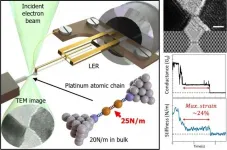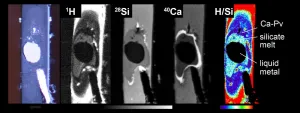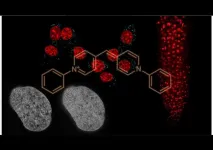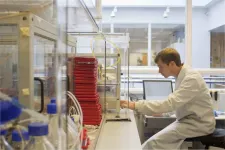The chemistry of magnesium turned on its head
FAU research team discovers completely new magnesium complexes
2021-05-14
(Press-News.org) The international scientific community agrees that the latest findings of an FAU research team will revolutionise the entire chemistry of magnesium. The research team have discovered magnesium, which usually has a double positive charge in chemical compounds, in the elemental zero-oxidation state. They have published their ground-breaking findings in the journal Nature.
In the periodic table of elements, magnesium (Mg) is a metal with low electronegativity, which means it does not easily attract electrons but easily loses both the electrons in its outer shell during chemical reactions. It therefore only exists in nature as a compound with other elements in the form of a positively charged Mg2+ cation. For example, this most stable form of Mg2+ is found in various minerals or in chlorophyll, which is the pigment that makes plants green.
Magnesium normally has double-positive charge, but now discovered in zero-oxidation state
The team at FAU led by Prof. Dr. Sjoerd Harder, Chair of Inorganic and Organometallic Chemistry, has now discovered the first complexes of magnesium in which the metal has a zero-oxidation state. The oxidation numbers in chemical compounds indicate the charge of the atoms, which means in this case that the researchers have managed to isolate elemental Mg in complex compounds.
As is so often the case in scientific research, this discovery was purely accidental. The research team had actually planned to split magnesium-magnesium bonds in order to produce magnesium radicals. Metallic sodium was used during this synthesis. The predicted result of the experiment was that the sodium would transfer one electron to the magnesium. Astonishingly, however, two sodium atoms transferred electrons to the magnesium and an Mg(0) complex that has never previously been observed was formed. The Mg centres in these complexes formally even carry a negative charge due to a unique magnesium sodium bond and thus react completely differently than conventional Mg2+ compounds. Whereas the electron-poor Mg2+ cations can accept electrons, the electron-rich Mg(0) reacts like a negatively charged anion by losing electrons.
This complex is soluble in organic solvents like toluene or benzene and is an extremely strong reducing agent, which is an element or compound that donates electrons to another element or compound. Slightly heating the complex led the Mg(0) to donate some of its electrons to the positively charged sodium cation (Na+), which then became elemental sodium metal Na(0). This is quite unusual, since sodium itself is a metal that has an even stronger tendency to lose electrons. This reaction created a new complex: three atoms of magnesium strung together like beads on a necklace. This triple core magnesium cluster reacts like atomic Mg(0) and can be considered as the smallest form of magnesium metal, one that is soluble in organic solvents. This new class of magnesium complexes represents a landmark in the chemistry of magnesium. The FAU research team led by Prof. Harder expect to discover further unusual reactivity of this soluble and extremely strong reducing agent.
INFORMATION:
ELSE PRESS RELEASES FROM THIS DATE:
2021-05-14
Ishikawa, Japan - Today, many well-studied materials in various fields, such as electronics and catalysis, are close to reaching their practical limits. To further improve upon modern technology and outperform state-of-the-art devices, researchers looking for new functional materials have to push the boundaries and explore more extreme cases. A clear example of this is the study of low-dimensional materials, such as monoatomic layers (2D materials) and monoatomic chains (1D materials).
It has been proved time and time again that low-dimensional materials exhibit exotic properties that are absent in their 3D bulk counterparts. For example, monoatomic chains of metals like gold ...
2021-05-14
High-temperature and high-pressure experiments involving a diamond anvil and chemicals to simulate the core of the young Earth demonstrate for the first time that hydrogen can bond strongly with iron in extreme conditions. This explains the presence of significant amounts of hydrogen in the Earth's core that arrived as water from bombardments billions of years ago.
Given the extreme depths, temperatures and pressures involved, we are not physically able to probe very far into the earth directly. So, in order to peer deep inside the Earth, researchers use techniques involving seismic data to ascertain things like composition and density of subterranean material. Something that has stood out for as long as these kinds of measurements have been taking place is that the core is primarily ...
2021-05-14
The ease with which anyone can create online content for free, especially on social media, has led to superabundance of information being one of the defining characteristics of today's communication systems. This situation has resulted in increasingly intense competition for attention, which has become a scarce good. The researchers from the Complex Systems group (CoSIN3) at the UOC's Internet Interdisciplinary Institute (IN3) María José Palazzi and Albert Solé --professor at the Faculty of Computer Science, Multimedia and Telecommunications?--, led by Javier Borge, have participated in the design of ...
2021-05-14
When it comes to ancient Roman imperial architecture, most people usually have a mental image of white marble statues, columns, or slabs. While it is true that many buildings and squares at that time were decorated with marble, it was frequently not white but colored marble that was employed, such as the green-veined Cipollino Verde, which was extracted on the Greek island of Euboea. Because marble was very expensive, it was often placed in thin slabs as a cladding over other, cheaper stones. "To date, however, no actual remains of marble workshops from the Roman imperial era have been found, so little is known about marble processing during this period," said Professor Cees Passchier ...
2021-05-14
An international research team analyzed a database of more than 1000 supernova explosions and found that models for the expansion of the Universe best match the data when a new time dependent variation is introduced. If proven correct with future, higher-quality data from the Subaru Telescope and other observatories, these results could indicate still unknown physics working on the cosmic scale.
Edwin Hubble's observations over 90 years ago showing the expansion of the Universe remain a cornerstone of modern astrophysics. But when you get into the details ...
2021-05-14
A group of scientists at Nagoya University, Japan, have developed an incredibly versatile DNA fluorescent dye, named 'Kakshine' after a former NU student of its members, Dr Kakishi Uno, but it also means to make the nucleus shine brightly, since the nucleus is pronounced 'Kaku' in Japanese. Dr Uno, with Dr Yoshikatsu Sato and Nagisa Sugimoto, the other two members of the research team at the Institute of Transformative Bio-Molecules (ITbM), succeeded in developing a DNA binding fluorescent dye with the pyrido cyanine backbone, which satisfied the three principal qualities required of such a dye - that it have high selectivity for DNA, ability to use visible light with limited phototoxicity, ...
2021-05-14
A new method to analyse the blood thinning drug Heparin has been developed that can pinpoint contaminants more accurately and quickly, providing greater quality control and safety.
An interdisciplinary team from the University of Nottingham's Schools of Pharmacy and Medicine have used the latest chemical imaging technology to identify contaminants in Heparin at the nanoscale, a discovery that manufacturers could use to improve the quality and safety of this widely used anticoagulant drug. The research has been published in Communications Chemistry.
Heparin is naturally occurring glycosaminoglycan ...
2021-05-14
ATS 2021, New York, NY - The use of e-cigarettes is associated with wheezing and shortness of breath in young adults and adolescents, even in those who don't smoke cigarettes or marijuana, according to research presented at the ATS 2021 International Conference.
Alayna P. Tackett, PhD, assistant professor of preventive medicine, University of Southern California Keck School of Medicine, and colleagues conducted a web-based survey of 2,931 adolescents and young adults (average age: 18.9) with questions on the use of e-cigarettes, cigarettes and cannabis, along with self-reported asthma diagnosis and respiratory symptoms, over the previous 30 days. The survey was fielded between August 6 and 30, 2020 among a national convenience sample of youth and young ...
2021-05-14
ATS 2021, New York, NY - Individuals with asthma who live in redlined neighborhoods have worse lung function than those in locales that excluded Black people and benefited from decades of inequitable wealth accumulation at the expense of Black communities in the United States, according to research presented at the ATS 2021 International Conference.
Alexander Schuyler, MD/PhD candidate, University of Pittsburgh School of Medicine, and Sally Wenzel, MD, director, Asthma & Environmental Lung Health Institute, University of Pittsburgh Medical Center, sought to examine the connection between residence in historically ...
2021-05-14
Session: TP16
Abstract Presentation Time: Available On-Demand; 8 a.m. EDT, Friday, May 14, 2021
ATS 2021, New York, NY - While vaping is thought to be a safer alternative to smoking, teens and adults who use e-cigarettes have increased odds of developing asthma and having asthma attacks, according to research presented at the ATS 2021 International Conference.
Teresa To, PhD, senior scientist in the Child Health Evaluative Sciences program at The Hospital for Sick Children (SickKids), and colleagues sought to determine whether youth and young adults ...
LAST 30 PRESS RELEASES:
[Press-News.org] The chemistry of magnesium turned on its head
FAU research team discovers completely new magnesium complexes





